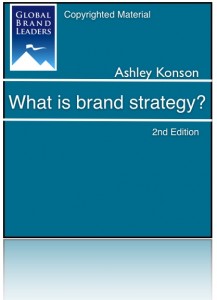What Is Brand Strategy?

I posed the question, What is Brand Strategy? at a recent workshop. It’s a question I usually ask executives at the start of a Global Brand Leaders training session.
Many attendees think the term brand strategy means branding, that is to say, choices regarding primary branding elements like brand name, logo, and visual identity. Or, they link brand strategy to choices of marketing communications such as advertising, publicity, social media, or to the company’s website. A few mention the important role that other aspects of the marketing mix—products, place, price, and people—frequently play due to their “branding effects.”
My typical response to this question is intended to illuminate the distinction between brand strategy and branding and to strengthen the argument that brands win in the marketplace when they conceive of a competitive strategy (be it referred to as brand strategy OR business strategy OR as we like to refer to it at Global Brand Leaders, as simply, strategy) for creating a unique and valuable position in the minds of customers.
Brand strategy is NOT branding
Branding seeks to achieve two important goals:
- To help customers identify your company and its products and services
- To shape customers perceptions about your company, and its products and services in a way that is meaningful to them so they perceive compelling functional and emotional benefits from their interactions and experiences with the brand
While it’s obvious that branding is a crucial part of a company’s brand strategy, it represents only a part of the story because branding decisions occur during the execution phase of a company’s brand strategy. And before you can execute on a brand strategy you must first conceive of that brand strategy.
Brand strategy is more than branding. It is a well-conceived competitive strategy that can foster the right branding and customer experiences for a company, and its products and services, to win in the marketplace.
A well-conceived brand strategy is a powerful business strategy (and vice versa)
A winning brand strategy is synonymous with a winning business strategy. It takes a well-conceived and executed business strategy to build a strong brand and business. It takes a well-conceived and executed brand strategy to build a strong brand and business. It’s the same thing.
Whether you call it business strategy or brand strategy, it is about focusing your business on winning with the customers you choose to serve by creating, delivering, and communicating a compelling value for them. This imperative to win with customers by providing them with compelling value is what defines brand strategy, or business strategy, if you prefer.
Every brand strategy must answer two key questions: Where to play? and How to win?[1] The answers to these two questions define the competitive strategy for a brand and business.
Where to play? requires decisions about the product-markets in which the brand and business will compete (the segment(s) of customers it will choose to serve based on knowledge of their unfulfilled or unrealized functional and emotional needs—and equally important, those customers it will not) and the level of investment that it must make to be successful.
How to win? requires decisions regarding the value proposition that a brand and business seeks to deliver to its customers if it is to satisfy their unfulfilled or unrealized needs, the assets and competencies required for this purpose, and the functional strategies and programs to be employed in order to deliver on the chosen strategy. (Branding choices take place once decisions have been made on Where to play? and on what Value Proposition needs to be delivered to the customers that will be served.)
It is the answers to these two questions that define the essence of business strategy. It is the answers to these two questions that define the essence of brand strategy. Again, it’s the same thing.
brand strategy is business strategy
The real battleground for every brand is in the customer’s mind. Brands win on this battleground when they create a unique and valuable position in the minds of customers. This occurs when brands prove themselves capable of creating, delivering, and communicating a compelling value for the customers they are choosing to serve.
This then is the true meaning of brand strategy!













